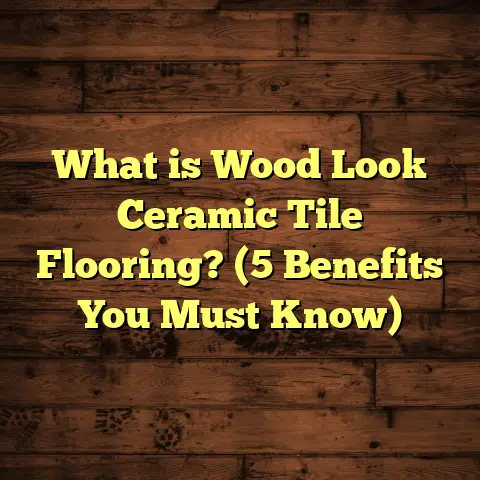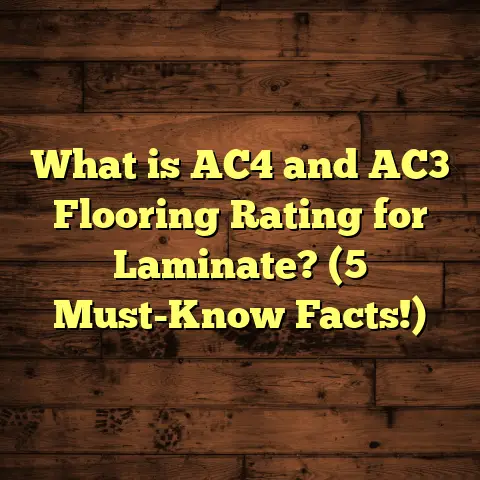What is a Hardwood Floor? (5 Key Features You Must Know!)
Noise Reduction and Hardwood Floors: Why This Matters More Than You Think
Have you ever stepped into a room and immediately felt how peaceful it was? Or walked in and thought, “Wow, this floor really makes the space feel lively,” because of all the echoes and noise? When I started working with hardwood floors, I was quite surprised by how they affected sound — not just visually but acoustically. Most people don’t realize that hardwood floors can help reduce noise under the right conditions.
You might think hard surfaces just bounce sound around, making rooms louder, right? That’s partially true—but hardwood floors paired with quality underlayment or padding can absorb sound vibrations and reduce noise transmission between floors. This means less echo within rooms and fewer footsteps heard downstairs.
I’ve installed hardwood floors in many homes where noise reduction was a priority—like apartments or multi-level houses. In one project, a client who lived in a busy urban area told me their new hardwood floors made a noticeable difference; their evenings felt quieter and more relaxing. This is something to keep in mind if you want a beautiful floor that also helps your home feel calm.
Sound impact tests show hardwood floors with underlayment can reduce impact noise levels by up to 20 decibels compared to bare concrete or tile. That’s significant in creating a comfortable living environment, especially for families. So, before dismissing hardwood floors as noisy, consider this: their sound qualities depend a lot on installation and materials beneath them.
What Exactly Is Hardwood Flooring?
So now that we’ve talked about noise, let’s get down to basics: what is hardwood flooring?
At its core, hardwood flooring is flooring made from solid wood harvested from deciduous trees—trees that lose their leaves every year. These woods include popular species like oak, maple, cherry, walnut, and hickory. The wood is cut into planks or strips, then finished and installed as the walking surface in your home.
Hardwood floors come mainly in two types:
- Solid Hardwood: These consist of a single piece of wood throughout the entire thickness—usually about ¾ inch thick. They’re typically nailed or stapled to a wooden subfloor.
- Engineered Hardwood: This type has a top veneer layer of real hardwood glued over multiple layers of plywood or high-density fiberboard. It offers better resistance to moisture and temperature changes.
I’ve worked extensively with both types, and each has its place depending on your home’s needs. Solid hardwood is often prized for its traditional look and ability to be refinished multiple times. Engineered hardwood is more versatile for installation over concrete slabs or radiant heating systems.
The defining characteristic of hardwood flooring is its natural wood composition, which gives it unique beauty and durability unmatched by synthetic alternatives like laminate or vinyl.
1. Durability That Lasts Generations
Durability is one of the strongest reasons I often recommend hardwood floors to clients looking for longevity. Hardwood is naturally dense and hard, which makes it resistant to dents, scratches, and general wear from daily life.
To understand this better, let me share some technical insight: the Janka hardness test measures wood’s resistance to denting by testing how much force it takes to embed a steel ball halfway into the wood. Oak, for instance, scores about 1,200 on this scale, which means it can withstand considerable pressure without damage.
In contrast, softer woods like pine have scores closer to 400 — meaning they dent more easily. Knowing this helps you choose the right species for your lifestyle. If you have kids or pets (which many of my clients do), opting for harder woods like white oak or hickory makes sense.
Here’s a personal story: I installed white oak hardwood flooring in a home with three children and two large dogs. The family worried about scratches and damage but wanted the warmth of real wood. Six years later, those floors still looked amazing with only minor surface marks that were easy to refinish. They told me it felt like they made an investment in their home’s future.
Hardwood floors can last decades—sometimes over 100 years—with proper care. That kind of durability means you won’t need to replace your flooring often, which saves money over time despite higher initial costs.
How Durability Varies Among Wood Species
Not all wood species are created equal when it comes to hardness:
| Wood Species | Janka Hardness Rating | Common Uses |
|---|---|---|
| Oak (White & Red) | ~1,200 | Flooring, furniture |
| Maple | ~1,450 | High-traffic areas |
| Hickory | ~1,820 | Heavy-use environments |
| Walnut | ~1,010 | Luxury flooring |
| Pine | ~420 | Budget or rustic styles |
Choosing the right wood based on your needs can mean fewer repairs and longer-lasting beauty.
2. Natural Beauty That Never Goes Out of Style
What first attracted me to hardwood floors was their natural charm. No two planks are identical—each has unique grain patterns, knots, and color variations that give character to your home.
One installation I fondly remember involved walnut flooring with deep chocolate hues and swirling grain that created a warm ambiance in the client’s family room. They said it felt like the floor had its own soul.
Hardwood floors also age gracefully. Over time, exposure to sunlight changes their color slightly—sometimes darkening or lightening depending on species—which adds depth and personality rather than wear.
This natural appeal is why hardwood flooring remains popular even as new materials enter the market. It offers an organic warmth that synthetic options struggle to match.
Customization With Stains and Finishes
Beyond natural color variations, you can customize hardwood floors with stains or finishes to match your style. I’ve seen everything from light whitewashed oak for beachy vibes to rich espresso tones for modern elegance.
Finishes protect the wood while enhancing its look:
- Polyurethane: Durable and water-resistant; available in satin, semi-gloss, or gloss levels.
- Oil-based finishes: Penetrate wood deeply for a natural feel but require more maintenance.
- Hardwax oils: Combine protection with a matte finish often preferred by designers.
Stain choices open up even more options—lighter stains brighten rooms while darker stains add drama.
3. Easy Maintenance and Long-Term Cost Benefits
You might wonder if hardwood floors require complex upkeep. Truthfully, they are easier to maintain than many people think.
Routine cleaning involves sweeping or vacuuming to remove dirt that could scratch the surface. Damp mopping with specialized hardwood cleaners keeps floors spotless without stripping finishes.
Every few years—or sooner if needed—you can refinish hardwood floors by sanding down surface scratches and applying fresh finish coats. This process renews the floor’s appearance and protects it for years ahead.
From a financial standpoint, hardwood floors may cost more upfront—between $6 and $12 per square foot for materials alone—but their longevity often makes them worth the investment. You’re less likely to replace hardwood multiple times like carpet or laminate.
A recent study showed homes with hardwood floors sold for an average 2-3% higher price than comparable homes without hardwood, highlighting their value addition.
My Experience With Maintenance
In my own home, I clean my hardwood floors weekly and refinish them after about 7 years. The results are always rewarding—fresh floors that look new again without full replacement costs.
Clients often tell me they appreciate how durable yet low-maintenance hardwood floors are compared to other options that stain or wear out quickly.
4. Environmental Impact: A Cleaner Choice
If you’re environmentally conscious, you might ask whether hardwood flooring fits your values.
The good news: when sourced responsibly from sustainably managed forests certified by organizations like the Forest Stewardship Council (FSC), hardwood is renewable and eco-friendly. It’s biodegradable and can be recycled or repurposed at end of life.
Because hardwood floors last so long, they reduce waste compared to short-lived materials like vinyl or carpet that need frequent replacement.
I spoke with several industry experts who emphasized that choosing FSC-certified products ensures you’re supporting sustainable forestry practices that protect ecosystems while providing quality materials.
A study by the National Wood Flooring Association found FSC-certified hardwood flooring reduces carbon footprint by up to 30% compared to synthetic alternatives—an important factor for green building projects.
What About Engineered Hardwood?
Engineered hardwood also has environmental benefits because it uses less precious hardwood veneer on top of plywood cores that utilize fast-growing trees or recycled wood fibers.
This means less impact on old-growth forests while still enjoying real wood surfaces.
5. Versatility in Design and Installation Options
Another reason I love working with hardwood floors is their incredible design flexibility.
You can choose from dozens of wood species, plank widths—from narrow strips around 2” wide to wide planks over 7”—and countless stains and finishes tailored to your taste.
Installation methods vary too:
- Nail-down: The classic approach for solid hardwood over wooden subfloors.
- Glue-down: Common for engineered planks on concrete slabs.
- Floating: Boards interlock without glue or nails, popular with DIYers or over radiant heat systems.
Certain species and installation methods work better in specific rooms or climates. For example, engineered hardwood is ideal for basements or areas prone to moisture because of its dimensional stability.
An Installation Story Worth Sharing
I once installed engineered hardwood in a basement family room with radiant floor heating underneath. The homeowner loved how warm their feet felt during winter—something impossible with tile or laminate—and the floor handled temperature swings perfectly without warping.
They told me it completely transformed their space into a cozy retreat everyone enjoyed using year-round.
Extra Insights: Hardwood Floors vs Other Flooring Types
You might be curious how hardwood compares side-by-side with other popular flooring options like laminate, vinyl plank, tile, or carpet.
| Flooring Type | Durability | Maintenance | Cost Range (per sq.ft.) | Noise Impact | Environmental Impact |
|---|---|---|---|---|---|
| Hardwood | High | Moderate (refinishing) | $6 – $12+ | Medium (with underlayment) | Renewable (if certified) |
| Laminate | Moderate | Low | $1 – $5 | Higher echo | Less eco-friendly |
| Vinyl Plank | Moderate | Low | $2 – $7 | High echo | Petroleum-based |
| Tile (Ceramic/Porcelain) | Very High | Low | $5 – $15+ | Very high echo | Energy-intensive to produce |
| Carpet | Low | High (cleaning) | $2 – $8 | Very quiet | Synthetic materials |
This table shows why hardwood strikes a balance between durability, beauty, environmental sustainability, and moderate noise control—especially when combined with sound-absorbing underlayment.
What About Cost? Breaking Down Expenses
Understanding costs helps avoid surprises during projects:
- Material Costs: Hardwood prices vary by species; exotic woods cost more.
- Installation: Labor rates depend on region; nail-down tends to cost less than glue-down.
- Underlayment: Adds around $0.50-$1 per sq.ft but improves comfort & sound control.
- Finishing: Prefinished boards save time; unfinished require onsite sanding & finishing.
- Additional Costs: Removal of old flooring, subfloor repairs can add expenses.
Using tools like FloorTally helps estimate local material and labor costs accurately based on project size—something I recommend clients try for budgeting.
Final Thoughts From My Experience
Hardwood flooring isn’t just about looks; it’s a smart investment in comfort, durability, environmental responsibility, and lasting home value.
Over years of working on diverse projects—from urban apartments needing quiet spaces to sprawling family homes demanding toughness—I’ve seen firsthand how choosing the right type of hardwood floor transforms living spaces in meaningful ways.
If you’re considering new flooring or upgrading your current surfaces, think about what matters most to you: style? Longevity? Noise reduction? Eco-friendliness? Hardwood delivers on all fronts when selected thoughtfully.
Want advice on picking species or installation styles? Curious about maintenance tips that keep floors looking great? Just ask—I’m here to help!
Would you like me to share detailed tips on caring for your hardwood floors next? Or perhaps explore popular wood species trends in 2025? Let me know!





